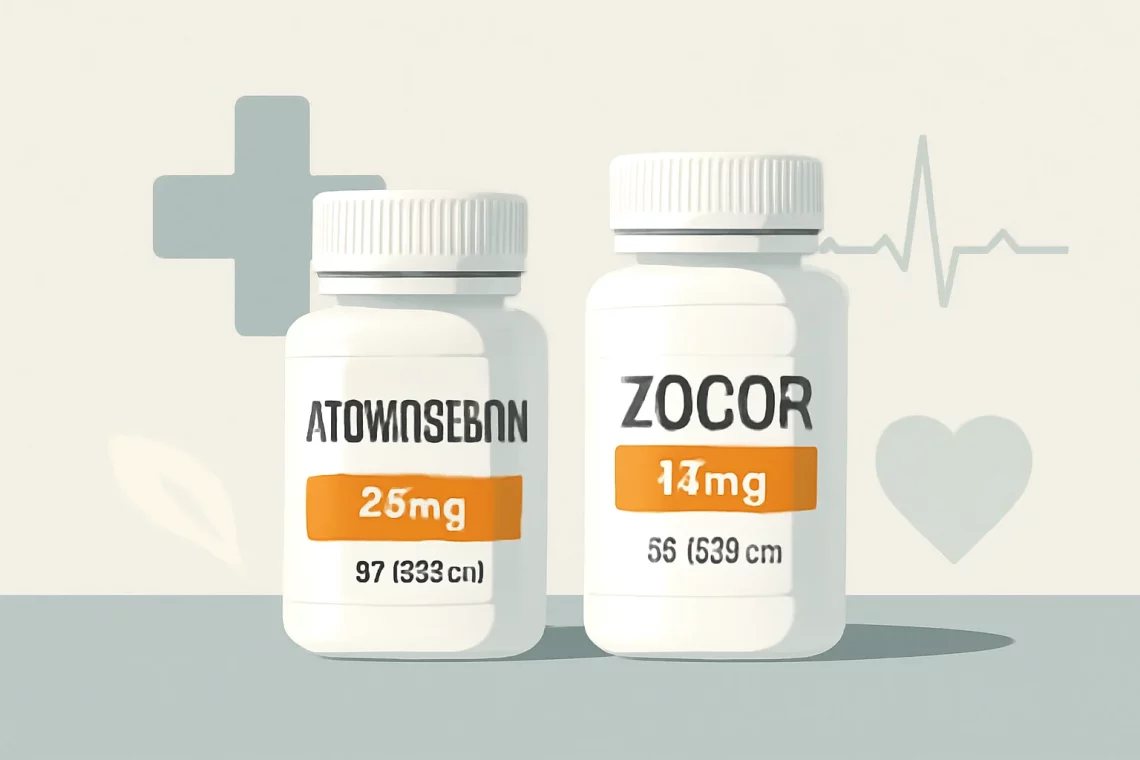
Atorvastatin vs Zocor: Which Cholesterol Medication is Right for You?
Atorvastatin and Zocor are two medications commonly prescribed to manage cholesterol levels and reduce the risk of cardiovascular diseases. Both belong to a class of drugs known as statins, which work by inhibiting the enzyme HMG-CoA reductase, crucial for cholesterol production in the liver. High cholesterol levels can lead to atherosclerosis, a condition where arteries become narrowed and hardened, increasing the risk of heart attacks and strokes.
The importance of managing cholesterol levels has become a focal point in preventive healthcare. With cardiovascular diseases being among the leading causes of death worldwide, understanding the options available for cholesterol management is essential. Statins, including atorvastatin and Zocor, have proven effective in lowering low-density lipoprotein (LDL) cholesterol, often referred to as “bad” cholesterol, while simultaneously raising high-density lipoprotein (HDL) cholesterol, known as “good” cholesterol.
As more patients and healthcare providers look for effective treatments, the comparison between atorvastatin and Zocor becomes increasingly relevant. Each medication has its unique characteristics, including dosage, efficacy, side effects, and interactions with other medications. This article delves into the differences and similarities between atorvastatin and Zocor, providing a comprehensive overview of each medication’s role in cholesterol management.
Understanding Atorvastatin
Atorvastatin is a widely used statin that has gained popularity due to its efficacy and safety profile. It works by inhibiting the HMG-CoA reductase enzyme, leading to a decrease in cholesterol synthesis in the liver. This action results in a significant reduction in LDL cholesterol levels, which is crucial for individuals at risk of cardiovascular diseases.
One of the primary benefits of atorvastatin is its flexibility in dosing. It is available in various strengths, allowing healthcare providers to tailor treatment based on individual patient needs. The usual starting dose is often low, which can be gradually increased depending on the patient’s response and cholesterol levels. This titration allows for a personalized approach to managing cholesterol while minimizing the risk of side effects.
Research has shown that atorvastatin not only lowers LDL cholesterol but also has additional benefits, such as reducing inflammation and stabilizing atherosclerotic plaques. These properties contribute to its cardiovascular protective effects, making it a preferred choice for many healthcare providers when prescribing cholesterol-lowering medications.
However, like all medications, atorvastatin is not without its side effects. Commonly reported side effects include muscle pain, digestive issues, and liver enzyme changes. Most patients tolerate atorvastatin well, but it is essential for healthcare providers to monitor patients regularly to detect any adverse effects early.
Atorvastatin is also known for its interaction with other medications. Patients taking multiple medications should inform their healthcare providers about all substances they are using to avoid potential interactions that could affect the efficacy of atorvastatin or lead to increased side effects.
Exploring Zocor
Zocor is the brand name for simvastatin, another well-known statin medication. Similar to atorvastatin, Zocor works by inhibiting HMG-CoA reductase, leading to reduced cholesterol production in the liver. It is particularly effective at lowering LDL cholesterol levels, which makes it a vital option for patients with hyperlipidemia.
Zocor has been used for several years and has a solid track record of safety and efficacy. The medication is typically prescribed in the evenings, as cholesterol synthesis in the liver is highest during the night. This timing can enhance the drug’s effectiveness in lowering LDL cholesterol levels.
One of the advantages of Zocor is its cost-effectiveness, making it an appealing choice for many patients, especially those without insurance coverage for brand-name medications. The generic formulation of simvastatin is widely available and often more affordable than some of its competitors.
However, Zocor also comes with its share of side effects. Patients may experience muscle pain, weakness, and gastrointestinal issues. In rare cases, more severe side effects can occur, such as rhabdomyolysis, a serious condition that can lead to kidney damage. Due to these risks, healthcare providers must assess the patient’s risk factors before prescribing Zocor.
Additionally, Zocor has specific drug interactions that patients need to be aware of. Certain medications, especially those that affect liver enzymes, can increase the risk of side effects when taken with Zocor. Thus, clear communication between patients and their healthcare providers is essential to ensure safe and effective treatment.
Comparing Efficacy and Safety
When comparing atorvastatin and Zocor, one must consider their efficacy and safety profiles. Both medications effectively lower LDL cholesterol levels and reduce the risk of cardiovascular events. However, studies have shown that atorvastatin may offer additional benefits in terms of overall cardiovascular protection.
Atorvastatin has been associated with a more significant reduction in LDL cholesterol levels compared to Zocor. This enhanced efficacy may be particularly beneficial for patients with very high cholesterol levels or those with a history of cardiovascular disease. In addition, atorvastatin’s ability to stabilize atherosclerotic plaques may provide an extra layer of protection against heart attacks and strokes.
On the safety front, both medications share similar side effects, including muscle pain and digestive issues. However, atorvastatin tends to have a slightly better safety profile, with fewer reports of severe muscle-related side effects compared to Zocor. This distinction may make atorvastatin a more suitable choice for patients with a higher risk of muscle-related complications.
Moreover, the interaction profiles of atorvastatin and Zocor differ. Atorvastatin has a broader therapeutic range and is less affected by certain drug interactions, making it a more versatile option for patients on multiple medications. Zocor, on the other hand, has more stringent contraindications, particularly concerning medications that can elevate the risk of severe muscle damage.
Ultimately, the choice between atorvastatin and Zocor should be based on individual patient needs, preferences, and potential risk factors. A thorough discussion between the patient and healthcare provider can help determine the most appropriate medication for effective cholesterol management.
Conclusion
In conclusion, both atorvastatin and Zocor play essential roles in managing high cholesterol levels and reducing the risk of cardiovascular diseases. Each medication has its advantages and disadvantages, making it crucial for patients to work closely with their healthcare providers to determine the best course of action.
While atorvastatin may offer enhanced efficacy and a better safety profile, Zocor remains a cost-effective and widely used option. Understanding the differences between these two medications can empower patients to make informed decisions about their health.
As always, it is important to consult with a healthcare professional before starting or changing any medication regimen. This article is not intended as medical advice. If you have any health concerns or questions about medications, please consult your doctor or a qualified healthcare provider.




